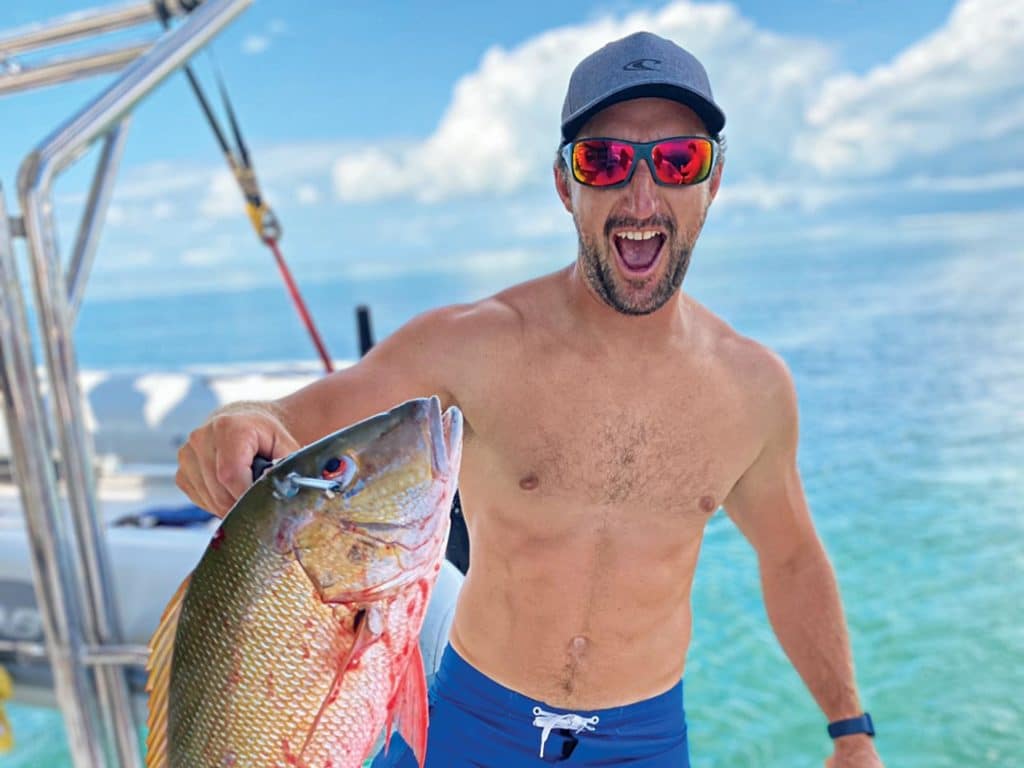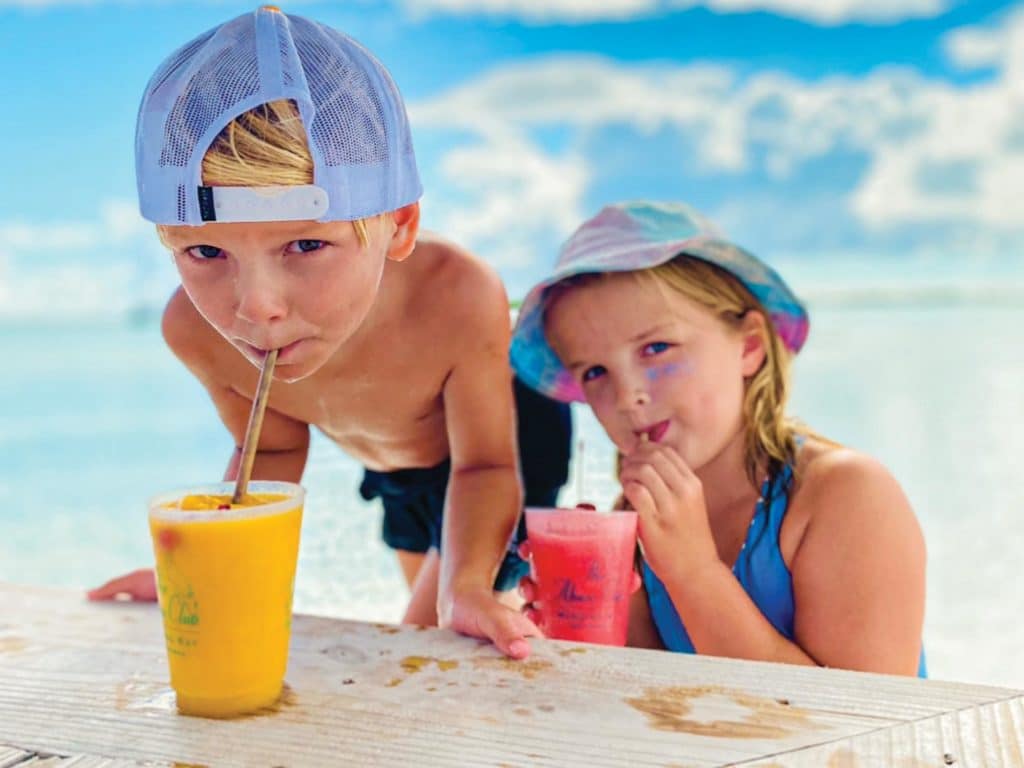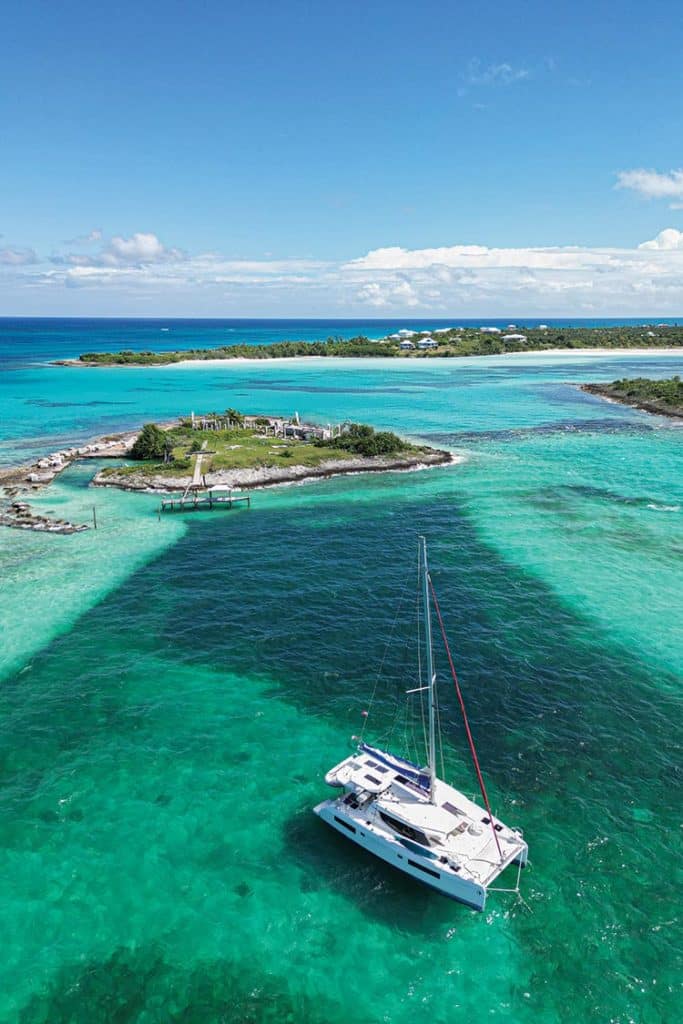
I get bored easily, which is probably because my day job is primarily racing SailGP’s F50 foiling catamaransg at 50-plus knots against eight other boats on impossibly short racecourses. My version of a family holiday has nothing to do with sitting on a beach sipping piña coladas or wasting away in Margaritaville, which is why when my family goes on vacation it can be a challenge to find something that keeps everyone entertained. My 6-year-old daughter wants friends to play with and ideally a lot of animals. My wife likes an adventure but also appreciates just relaxing in the sun. And me? Like I said, sitting around doing nothing is just not my thing, and that’s why a bareboat sailing vacation ticks all my boxes.
A charter catamaran is, of course, nothing like any of the America’s Cup or grand-prix boats I’ve played on for many hours over the years. When the sails go up, I’ll be lucky to get the boatspeed into double figures, but there’s always fine-tuning to do—you know I can’t be seen sailing around with a bad leech profile or creases coming out of mainsail batten pockets. If there’s another boat with sails nearby, there’s no rest until I’m higher and faster. When the sails are stowed, there’s elaborate fishing contraptions to build, wrecks to snorkel and lobsters to catch. Throw in a wing and a foil board, and the holiday is pretty ideal for me.
But a vacation is not all about me. For my daughter, it is great to invite another family so she has friends to adventure with. For my wife, short passages afford her stretches of sun-soaked relaxation on the bow, local restaurants and, most importantly, quality family time, which is more valuable than you can imagine for pro sailors like me.
Last year, we took on our first family bareboat charter in the British Virgin Islands and had an amazing trip. This year, I pitched something more adventurous and somewhere none of us had been before. A certain Sailing World editor friend told me about the Abacos in the Bahamas, where Sunsail had reopened its base after Hurricane Dorian leveled the area in 2019. He promised the kids would love it, the sailing is easy, and the islands are all unique. Upon his recommendation, we booked a charter without knowing anything about the place, and so our adventure began.
Flying into the Abacos today showcases the destruction still present. Acres of palm trees that used to stand lush remain barren as far as we can see through the plane’s small oval windows. On the taxi ride to the hotel, our driver describes how the storm surge went above the first floor of every building in town. But a massive rebuild is happening, and beautiful pastel Caribbean-style buildings are popping up between the older weather-beaten structures.
The Sunsail and Moorings Marsh Harbour base is at the Abaco Beach Resort on the main island of Great Abaco, so we check into the hotel a couple of days early to get ourselves sorted. The kids, of course, find immediate entertainment at the pool while I rig my wing-foil gear on the beach right outside our room, a proper start to the vacation.
Our boat is a Sunsail 454 catamaran, a couple of years old but set up well. The kids get the forward cabins, and the parents claim the aft, all with comfy berths and hatches for sleepy stargazing. The handover process is simple, and Sienna, the base manager, gives me a full rundown of cool stuff to do in the Abacos—and what to avoid. So efficient is the checkout that we slip our lines early on the first day of our charter and go on our merry way.

For the first few days, we motorsail northwest, stopping at pristine beaches, anchoring on the calm south side of small cays, taking the tender to the beach, and crossing overland to play in the Atlantic surf on the north side. The kids love the big waves and the excitement of getting swept up and down the beach. They return to the boat covered head to toe in sand, and the benefit of energetic water play is obvious to the parental units: The kids are excited to climb into their berths, making the usual laborious process of bedtime a dream. As soon as they are tucked in, the music, card games and drinks come out.
Scotland Cay is the highlight of our first few days. Knowing next to nothing about it and only discovering it on Google Earth, we anchor outside a big bay surrounded by calm white-sand beaches, except a small cut-through at each end. Here, the kids collect shells and swim while the dads follow two eagle rays gliding in the cut. This alone is one of the most phenomenal things I’ve ever seen in the wild. While following them, we come across a four-by-four resting on the bottom, teeming with fish. It is close enough to the surface that we can dive down and touch it. We also discover that we’re anchored right above eight lobster pots, which are full of fish and a couple of small lobsters. After wrestling them to the surface—and checking for a while that nobody was coming to claim them—I call my fisherman friend, Alex Sinclair, my teammate and grinder on the US SailGP Team. He informs us we have a hogfish, which will make an awesome dinner.
The next morning, we head for one of the advertised attractions of the Abacos—the swimming pigs. When we do get to them on “No Name Cay,” the mix of reactions among the kids is hilarious. Some love their snouty faces and others run in fear, but it doesn’t take us long to work out they are just smelly hogs that don’t really want to go in the water.
Nunjack Cay is the farthest north we go. Armed with a couple of frankfurters, we head to the beach, where we were told is a good spot to feed stingrays and sharks. There are no sharks, but my wife manages to get the stingrays to eat sausages right out of her hand. The kids are ecstatic when a loggerhead turtle swims past while we’re paddleboarding—passing by close enough that we can touch its shell. When dolphins leap between the bows as we leave, our interaction with the wildlife proves to be a magical experience for all.
At this point, five days into our charter, we’ve barely used the sails, managing to plan every leg of our trip heading directly into the wind, so we turn south, kill the engines and set sail. In 12 knots of wind, the catamaran cruises easily at 7 knots—no flight controls, no wing to twist, no grinders hammering away. It’s all very relaxing.
As much as I enjoy sailing, it’s not often that I can run a fishing line out the back of the boat, so I spend hours setting up an elaborate system of hooks, lines and bungees and a Red Bull-can alarm system, which turns out to be successful. At times, we have to reduce from two trolls to one, as we are unable to retrieve the fish quick enough. Each time we land a fish, though, I speed-dial Sinclair for a consult. Most of them we release, but we do score one beautiful big snapper, which feeds us royally. Working out how to fillet and cook these things is a challenge none of us had ever faced, but one we all find entertaining.
We connect beach stops on our way south and do a bit of turtle watching in the mangroves from the tender before we pull into Great Guana Cay, where the kids find local children to play with and take full advantage of the restaurant’s bar-side pool. Up to this point, of the 10-plus beaches we’d been to and the 50 or so nautical miles we’d covered, we hadn’t seen another person, unbelievable considering they are some of the nicest beaches we’ve ever visited.
Next up is Hope Town to see the famous lighthouse, refuel, top up the water tanks and lunch at the Hope Town Inn, which gives us a true sense of how friendly the locals are. We are welcomed everywhere with open arms, with one guy even walking us to the supermarket rather than directing us.
Tahiti Beach is our next destination, and we’re excited because we’ve seen a lot of pictures. But when we arrive at high tide, there is barely any beach at all. Patience pays off as the tide drops and rewards us with an expansive and deserted white-sand haven loaded with conch shells, starfish and hermit crabs, a few of which would become onboard pets. The Thirsty Cuda Bar and Grill motors up, deploys its floating dining platforms, and serves up frozen drinks, much to everyone’s delight. I use this time to launch the wing-foil gear off the back of the yacht and have a rip across 3 feet of gin-clear water and pearl-white sand below.
A long downwind sail in 20 knots the following morning means we’re too fast for fishing, but we cover good distance. We pause at Pelican Cay to give the kids a chance to play in the waves on the beach in this beautiful nature reserve, finding a safe little area where the waves break through the rocks and push eddies and swirls. This amuses the kids—and me—for hours. In the late-afternoon sun, we continue to Little Harbor for the night and find a beautiful small anchorage full of beach bars not yet open for the season.
At first light, we exit the Abaco Sea and make our way to the Abaco Club on Winding Bay, an exclusive club surrounded by beautiful holiday houses, a links golf course, tennis courts and high-end restaurants that is kind enough to let us use its facilities for the day. It’s a super-shallow swimming spot, and here the children master kayaking independently, one of the highlights of their holiday. It gives them that little bit of independence to go off and spot turtles by themselves and leave the mums and dads enjoying warm water, soft sand and tranquility.
By the 10th day, we should be heading back to the base, but we’re having too much fun and extend the trip for two more nights. We take one more sail south into Cherokee Sound to discover the clearest water we have ever seen. At 14 meters deep, it looks as if it is only two.

We have a couple more things we want to tick off the bucket list up north, so we head back to Hope Town for breakfast before returning to our favorite spot in Scotland Cay and to the infamous Nippers Beach Bar and Grill for dinner. This place is super cool, with pastel-colored chairs looking down over Atlantic swells crashing onto empty white-sand beaches for miles. Here we have our first experience with sharks while diving to video a large starfish when four very calm 8-foot bull sharks come to say hello.
We return to Marsh Harbour in a big storm, welcomed with smiles by the soaking-wet base staff. After searching for our shoes, which we hadn’t seen for 12 days, we transfer to the hotel for one last pool and sleep session.
Since returning to the UK, I’ve had a lot of friends message me about the trip, curious about how much experience they need to charter a boat in the Abacos. It is so straightforward. With two engines positioned far apart, the catamarans are easy to maneuver under power, and the base staff are always reachable should anything need servicing during the charter. The handover process at the base at the beginning and end of the charter is comprehensive, and there is a thorough user manual on board if you forget anything from the briefing. They’ll even take the boat off the dock for you and bring it back at the end if you’d like. One bit of advice is to download the Navionics app on a phone or tablet. The app is useful for finding the shallow spots, researching the locations, and locating a few awesome wrecks just below the surface loaded with fish. A personal favorite is a sunken landing craft with a golf cart on the stern just off Sandy Cay, which you can swim down to and pretend to drive.
For anyone looking for an idyllic family holiday, I would absolutely recommend doing a bareboat charter. With sailing experience and basic boat handling know-how, you can explore one of the most picturesque locations in the world, seeing beaches and wildlife accessible only by boat. The Abacos are just getting up and running again, so word to the wise to my sailing friends: Head there now to experience stunning and almost deserted locations. And do it with a bareboat.









